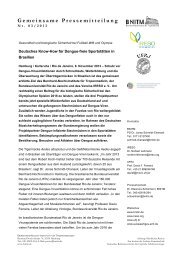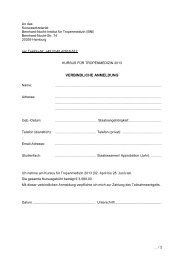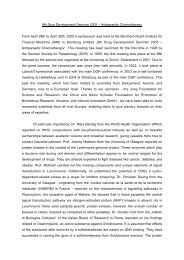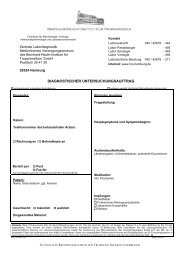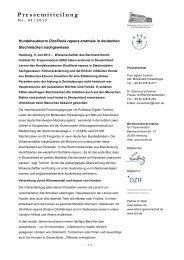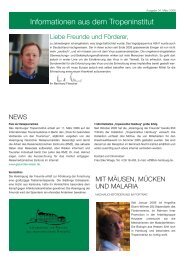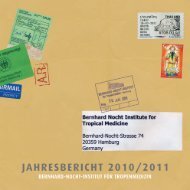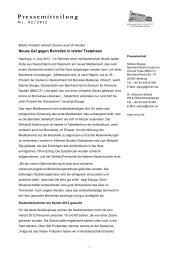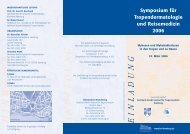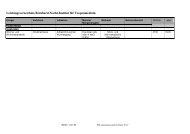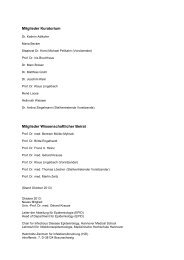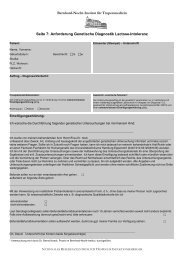Research Group Heussler (Malaria I) - Bernhard-Nocht-Institut für ...
Research Group Heussler (Malaria I) - Bernhard-Nocht-Institut für ...
Research Group Heussler (Malaria I) - Bernhard-Nocht-Institut für ...
Create successful ePaper yourself
Turn your PDF publications into a flip-book with our unique Google optimized e-Paper software.
Europeans, Europeans with intestinal helminths or with<br />
anti-rickettsial antibodies were positive. However, 28%<br />
of the sera from individuals from areas non-endemic for<br />
human filariasis in Africa recognized the antigen. Therefore,<br />
we searched for Wolbachia in non-filarial human<br />
parasites, which might induce also antibodies against<br />
Wolbachia antigens. Wolbachia were identified for the<br />
first time in large numbers in the ovary of the sand flea<br />
Tunga penetrans (Figure 2A). The aspartate aminotransferase<br />
gene of these Wolbachia was found to be<br />
very similar to the homolog in filarial Wolbachia and an<br />
immunological cross-reaction in humans is likely. The<br />
Wolbachia in T. penetrans can be also labeled by antibodies<br />
raised against a Wolbachia surface protein of<br />
filarial Wolbachia (Figure 2B). It can be concluded that<br />
specific IgG1 antibodies against Wolbachia antigens,<br />
such as aspartate aminotransferase, are induced by<br />
Wolbachia from filarial parasites, but a cross-reaction<br />
with Wolbachia from arthropods cannot be excluded.<br />
67<br />
Selected Publications<br />
• Büttner DW, Wanji S, Bazzocchi C, Bain O, Fischer P<br />
(2003).<br />
Obligatory symbiotic Wolbachia endobacteria are<br />
absent from Loa loa. Filaria J, 2:10.<br />
• Fischer P, Bonow I, Büttner DW, Kamal IH, Liebau E<br />
(2003).<br />
An aspartate aminotransferase of Wolbachia endobacteria<br />
of Onchocerca volvulus is recognized by<br />
IgG1 antibodies of residents from endemic areas.<br />
Parasitol Res, 90: 38-47.<br />
• Fischer P, Schmetz C, Bandi C, Bonow I, Mand S,<br />
Fischer K, Büttner DW (2002).<br />
Tunga penetrans: molecular identification of Wolbachia<br />
endobacteria and their recognition by antibodies<br />
against proteins of endobacteria from filarial parasites.<br />
Exp Parasitol, 102: 201-211.<br />
Funding<br />
• Vereinigung der Freunde des<br />
Tropeninstituts Hamburg e.V.<br />
Cooperating Partners<br />
• Claudio Bandi, University of Milano, Italy<br />
• Ibrahim H. Kamal, New England BioLabs, Beverly<br />
MA, USA<br />
Investigators<br />
• Peter Fischer<br />
• Insa Bonow<br />
• Michaela Krämling<br />
• Christel Schmetz<br />
• Dietrich W. Büttner<br />
Medical Microbiology Section<br />
Figure 2: Ultrastructural identification of Wolbachia in the ovary of the sand flea Tunga penetrans from Ghana.<br />
A Numerous Wolbachia endobacteria (inlay, arrows) in the cytoplasm of an egg follicle surrounded by follicular cells (fc) with large nuclei<br />
(nu). B Immunogold labeling of Wolbachia (arrow) using an antibody against a Wolbachia surface protein of Wolbachia from the filarial<br />
parasite Dirofilaria immitis.



